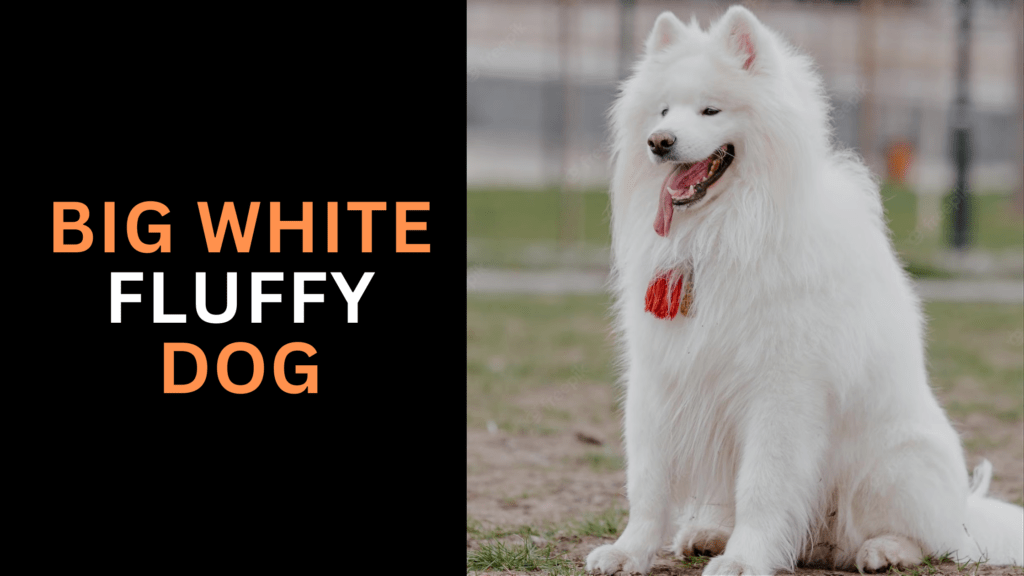A big white fluffy dog could be any number of breeds, but some of the most common ones include.
Great Pyrenees:
The Great Pyrenees, also known as the Pyrenean Mountain Dog, is a large breed of dog that originated in the Pyrenees Mountains of France and Spain. They were originally bred to guard flocks of sheep on steep mountain slopes, and as such, they are known for their strong protective instincts. They have a thick, fluffy coat that is predominantly white, with some markings of gray, tan, or badger.
These dogs are typically calm and gentle with their families but can be wary of strangers and other animals. They require regular exercise and grooming to keep their coats in good condition. Great Pyrenees are intelligent and independent, and can be stubborn at times, so early socialization and training are important. Overall, they make loyal and devoted companions for those who are prepared for their size and protective nature.
Samoyed:
The Samoyed is a beautiful and fluffy breed of dog that originated in Siberia. They were originally bred by the Samoyedic people to help hunt, herd, and pull sleds in the harsh Arctic climate.
Samoyeds are medium-sized dogs, with males typically weighing between 45-65 pounds and females weighing between 35-50 pounds. They have a thick, fluffy coat that is typically white or cream-colored, and they shed heavily twice a year.
Samoyeds are active dogs that require regular exercise and mental stimulation. They love to play and make great companions for outdoor activities such as hiking or jogging.
Overall, Samoyeds are loyal and loving dogs that make great family pets for those who are prepared to handle their grooming needs and energy levels.
American Eskimo Dog:
The American Eskimo Dog is small to medium-sized breed of dog that originated in Germany. Despite its name, it has no direct relation to the Eskimo people or their dogs. This breed was originally used as circus performers and was known for their intelligence and ability to learn tricks quickly.
American Eskimo Dogs get in three size varieties: toy, miniature, and standard. The toy variety stands 9-12 inches tall and weighs up to 10 pounds, while the miniature variety stands 12-15 inches tall and weighs up to 20 pounds. The standard variety stands 15-19 inches tall and weighs up to 35 pounds. They have a thick white coat, pointy ears, and curly tails.
American Eskimo Dogs are active and require regular exercise and mental stimulation. They also have a thick coat that requires regular brushing and grooming to prevent matting and tangles.
Overall, American Eskimo Dogs are loyal and loving companions that make great family pets for those who are prepared to provide them with the exercise, training, and grooming they require.
Kuvaszk:
Kuvaszk breed is originally bred to guard livestock and property, and as such, they have a strong protective instinct and can be wary of strangers.
Kuvaszk’s is a large and muscular dog, with males typically weighing between 100-115 pounds and females weighing between 70-90 pounds. They have a thick, white coat that is typically straight or wavy, and they shed moderately throughout the year.
These dogs are known for their independent and confident personalities. They require early socialization and training to prevent them from becoming overly aggressive or territorial.
Kuvaszk is an active dog that requires regular exercise and mental stimulation. They enjoy activities such as hiking, jogging, and obedience training
Overall, Kuvaszk is a loyal and protective dog that makes a great guardian for those who are prepared to provide them with the training, exercise, and socialization they require.
Maremma Sheepdog:
The Maremma Sheepdog, also known as the Maremmano-Abruzzese, is a large breed of dog that originated in Italy. They were originally bred to guard livestock, particularly sheep, and as such, they have a strong protective instinct.
Maremma Sheepdogs are large and muscular dogs, with males typically weighing between 77-99 pounds and females weighing between 66-88 pounds. They have a thick, white coat that is typically long and fluffy, and they shed heavily twice a year.
These dogs are known for their independent and reserved personalities. They require early socialization and training to prevent them from becoming overly aggressive or territorial.
Maremma Sheepdogs are active dogs that require regular exercise and mental stimulation. They enjoy activities such as hiking and obedience training
Overall, Maremma Sheepdogs are loyal and protective dogs that make great guardians for those who are prepared to provide them with the training, exercise, and socialization they require.
Conclusion:
In conclusion, big white fluffy dog are a popular and beloved group of dog breeds known for their thick coats, friendly personalities, and loyalty to their families. Popular breeds in this category include the Great Pyrenees, Samoyed, American Eskimo Dog, Kuvasz, Maremma Sheepdog, and Newfoundland.big white fluffy dog
FAQs:
What are some breeds of big fluffy dogs?
Some popular breeds of big fluffy dogs include the Great Pyrenees, Samoyed, American Eskimo Dog, Kuvasz, Maremma Sheepdog, and Newfoundland.
How do I groom a big fluffy dog?
Big fluffy dogs require regular grooming to prevent matting and tangles in their thick coats. This includes brushing their fur at least once a week, trimming any excess fur around their paw pads, and regular baths.
Are big fluffy dogs good with children?
Many big fluffy dogs, such as the Samoyed and American Eskimo Dog, are known for their friendly and outgoing personalities and make great family pets.
Do big fluffy dogs shed a lot?
Yes, many big fluffy dogs shed heavily throughout the year, particularly during shedding season. It is important to regularly groom and brush their coats to minimize shedding and prevent matting.
Are big fluffy dogs easy to train?
It depends on the breed and individual dog. Some big fluffy dogs, such as the Kuvasz, are known for their independence and can be stubborn at times.



